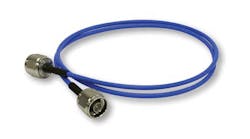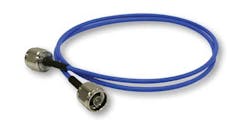Passive intermodulation (PIM) can be a pain for communications network operators. It is noise that results from the nonlinear mixing of two or more signals and, depending upon transmit power levels, PIM can occur at power levels sufficient to degrade system performance.
In a wireless base station, for example, PIM produced by a transmitter can compete at a receiver with signals uplinked from a mobile handset to that receiver. When the receiver can’t differentiate between the different types of signals, system performance suffers, resulting in lost data and dropped calls. Performing PIM measurements is one way to learn if a particular passive component will contribute to the PIM levels in a communications system.
The nonlinear effects that lead to PIM signals act very much like frequency mixers within a component or system, adding and subtracting fundamental tones and their harmonics to produce numerically related output signals. Two signals such as f1 and f2, will multiple together with different harmonics to produce PIM signal products as a function of Mf1 ± Nf2.
For example, the second harmonics of the first signal, 2f1, may add or subtract with the fundamental frequency of the first signal such as 2f1 ± f2, to produce PIM signals that may fall within the frequency range of the receiver and act as interference. The factors of the two signals, such as 2 + 1, determine the order of the intermodulation, with this example being a third-order case.
PIM can be caused by dirt, rust, or oxidation on electrical contacts, by loose or over-torqued connectors, by dissimilar metal conductors at electrical junctions, and by poorly attached connector/cable junctions. Even a system with the most well-designed components and carefully torqued connectors can suffer from PIM if PIM-susceptible materials, such as ferromagnetic materials, are used for the circuit boards or components.
Measurement systems for PIM can often be assembled with equipment at hand, using a power meter or some form of signal analyzer to measure the levels of the PIM signals generated by two test tones that are combined and conducted through a device under test (DUT). For many years, the basic IEC 62037 standard and updates from the International Electrotechnical Commission (IEC) have provided the guidance for performing consistent PIM measurements, using two 20-W (+43 dBm) test tones with 5 kHz bandwidth per carrier. The frequencies of the test tones will depend on the frequency of the particular application.
A number of test-equipment manufacturers provide excellent application notes on performing measurements with different types of analyzers, including spectrum analyzers and vector network analyzers (VNAs). A basic test setup might include two signal generators, two amplifiers to achieve the required test tone power, filters to reduce undesired test signal content, a two-way power combiner or directional coupler, and an analyzer, with low-PIM test cables used for interconnections.
PIM testing has traditionally been performed with fixed-frequency test tones as static measurements (fixed operating conditions), but such measurements may not adequately reveal the full PIM characteristics of a DUT; the PIM generated by a passive component is often a function of frequency, with different PIM levels produced for the same test-tone power levels at different test frequencies with the DUT operating bandwidth. A number of test-equipment manufacturers now offer equipment for performing swept-frequency PIM measurements to discover how a passive component’s PIM behavior might change with frequency.
In addition, PIM levels can change with time and changes in environmental conditions, such as vibration, temperature, and humidity. Dynamic testing can help evaluate the effects of vibration and changing temperature on PIM performance as a function of time. In all cases, when the PIM of a component is recorded and evaluated, it must be with reference to the test tone level or carrier level. When a spectrum analyzer reads a PIM signal level of -120 dBm at a particular frequency, for example, and the starting point was an input test tone power of +30 dBm, the DUT is actually producing PIM of -120 – 30 = -150 dBc.
For modern communications systems and their passive components, PIM measurements are not just for the research lab or production line: PIM performance can change in the field as a function of time. Rust forming on an antenna connector can degrade PIM and compromise system performance. Portable PIM measurement equipment capable of operating on battery power can be an invaluable asset as part of a measurement tool kit for outdoor, on-site wireless network and general communications system maintenance.


